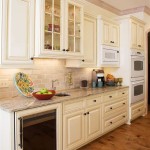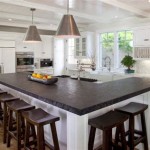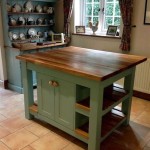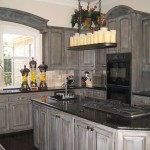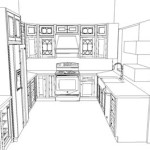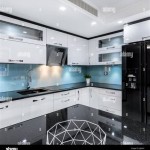How To Decorate A Kitchen Soffit
Kitchen soffits, those often-underappreciated spaces between the top of kitchen cabinets and the ceiling, can be a decorative challenge. Frequently perceived as purely functional elements housing ductwork, plumbing, or wiring, soffits are often left bland and unadorned. However, with a little creativity and planning, these spaces can be transformed from eyesores into attractive features that enhance the overall aesthetic of the kitchen. Effective soffit decoration not only improves the visual appeal but can also contribute to the perceived height and spaciousness of the room.
Before commencing any decorating project, it is crucial to understand the existing structure and purpose of the soffit. Attempting to alter or remove a soffit without prior assessment can lead to unforeseen issues, particularly if it contains essential utilities. Consult with a qualified contractor or structural engineer to determine the load-bearing capacity and any potential limitations. It is also important to consider the overall kitchen design and existing color scheme to ensure that any soffit decorations complement rather than clash with the existing décor.
Strategic Lighting Integration
One of the most effective ways to transform a kitchen soffit is through the strategic incorporation of lighting. Lighting serves both functional and aesthetic purposes, illuminating the workspace while simultaneously enhancing the visual appeal of the kitchen. There are several lighting options that can be considered for soffit applications, each offering a unique ambiance and level of illumination.
Recessed lighting is a popular choice for kitchen soffits due to its clean and minimalist design. These lights are discreetly installed within the soffit, providing focused downlighting that is ideal for illuminating countertops and workspaces. Recessed lighting can be adjusted to various angles and intensities, allowing for customized lighting solutions tailored to specific needs. When installing recessed lighting, it is important to ensure proper insulation and ventilation to prevent overheating.
Another option is the use of LED strip lights. These flexible lights can be easily installed along the edge of the soffit, creating a soft and ambient glow. LED strip lights are energy-efficient and long-lasting, making them a cost-effective lighting solution. They are also available in a wide range of colors, allowing for the creation of a dynamic and customizable lighting scheme. LED strip lights can be controlled with a dimmer switch, enabling adjustments to the brightness level to suit different moods and occasions. Consider using color-changing LED strips for a more dramatic effect, particularly in contemporary kitchen designs.
Pendant lights can also be incorporated into the soffit design, particularly if the soffit is deeper. Suspended from the soffit, pendant lights create a focal point and add visual interest to the kitchen. Choose pendant lights that complement the overall style of the kitchen, whether it is modern, traditional, or rustic. Pendant lights can be used to highlight specific areas, such as an island or breakfast bar.
When planning the lighting scheme for the soffit, consider the placement of the lights in relation to other light sources in the kitchen. The goal is to create a balanced and harmonious lighting environment that provides adequate illumination without causing glare or shadows. Utilize a combination of ambient, task, and accent lighting to achieve optimal results.
Decorative Molding and Trim
Decorative molding and trim can be added to a kitchen soffit to enhance its visual appeal and create a more polished and finished look. Molding and trim are available in a wide range of styles and materials, allowing for customization to match the existing kitchen décor. The addition of molding can transform a plain soffit into a more architectural and interesting feature.
One popular option is the use of crown molding. Crown molding adds a touch of elegance and sophistication to the kitchen. It is typically installed along the top edge of the soffit, creating a seamless transition between the soffit and the ceiling. Crown molding is available in various sizes and profiles, allowing for customization to suit the specific proportions of the kitchen. Choose a crown molding that complements the style of the cabinets and other architectural details in the room.
Another option is the use of decorative trim. Trim can be added to the front or sides of the soffit to create visual interest. Consider using trim with intricate patterns or details for a more ornate look. Trim can also be used to conceal any gaps or imperfections in the soffit. Choose a trim material that is durable and easy to clean, as kitchen environments are often prone to spills and splatters.
Beyond traditional wood molding, consider alternative materials such as metal or plaster for a more contemporary look. Metal trim can add a sleek and modern touch to the kitchen, while plaster moldings can provide a more textured and artistic appearance. Experiment with different finishes and colors to find the perfect complement to the existing décor. For example, a brushed nickel or stainless steel trim can create a modern aesthetic, while a painted or stained wood trim can provide a warmer and more traditional feel.
When installing molding and trim, it is important to ensure that the measurements are accurate and that the pieces are properly aligned. Use a level to ensure that the molding is installed straight and even. Fill any gaps or imperfections with caulk and then paint or stain the molding to match the existing décor. Consider using a primer before painting to ensure proper adhesion and a smooth finish.
Creative Surface Treatments and Textures
Beyond lighting and molding, the surface of the soffit itself can be treated to enhance its aesthetic appeal. A variety of techniques can be employed to add texture, color, and visual interest to the soffit, transforming it from a bland backdrop into a focal point. Consider these surface treatment options to personalize the kitchen space.
Painting the soffit a contrasting color is a simple yet effective way to add visual interest to the kitchen. Choose a color that complements the existing cabinets and countertops but stands out enough to draw the eye. A darker color can create a sense of depth and dimension, while a lighter color can make the kitchen feel more spacious. Consider using a semi-gloss or gloss paint for the soffit, as these finishes are easier to clean and maintain.
Adding texture to the soffit is another way to enhance its visual appeal. This can be achieved through various techniques, such as applying textured paint, wallpaper, or even faux finishes. Textured paint can create a subtle and understated effect, while wallpaper can add a more intricate and patterned design. Faux finishes, such as Venetian plaster or stucco, can provide a more dramatic and luxurious look. When choosing a texture for the soffit, consider the overall style of the kitchen and the existing textures in the room.
Another option is to apply decorative tiles to the soffit. Tiles can add a touch of elegance and sophistication to the kitchen, particularly if they are chosen to match the backsplash or countertops. Tiles are available in a wide range of materials, colors, and patterns, allowing for endless customization possibilities. Consider using mosaic tiles for a more intricate and artistic effect. When installing tiles on the soffit, it is important to ensure that the surface is properly prepared and that the tiles are securely adhered.
Consider incorporating a mural or painted design onto the soffit. This allows for a highly personalized and artistic expression. A mural can depict a landscape, a still life, or any other image that complements the kitchen's style. Consult with a professional artist to create a custom mural that is tailored to the specific dimensions and proportions of the soffit. A painted design can also be a simpler geometric pattern or abstract artwork.
The choice of surface treatment should consider the overall kitchen design and the desired aesthetic. Ensure that the chosen treatment complements the existing elements and contributes to a cohesive and visually appealing space. Proper preparation and execution are crucial for achieving a professional and long-lasting result.
Ultimately, decorating a kitchen soffit is about transforming a potentially overlooked area into a contributing element of the overall design. By carefully considering lighting, molding, and surface treatments, the soffit can be elevated from a purely functional space into a stylish and visually appealing feature of the kitchen. The key is to plan strategically, execute meticulously, and choose elements that complement the existing décor to create a cohesive and harmonious kitchen environment.

Diy Kitchen Soffit Makeover How To Disguise A Average But Inspired
:strip_icc()/101634871-9532042e1719420b859d6d4d4b732be3.jpg?strip=all)
16 Ideas For Decorating Above Kitchen Cabinets

Diy Kitchen Soffit Makeover How To Disguise A Average But Inspired

61 Kitchen Soffits Ideas Soffit Remodel Decor
:strip_icc()/101705919-46c69aadc4b1401fbb8383b607c37b36.jpg?strip=all)
16 Ideas For Decorating Above Kitchen Cabinets

Diy Kitchen Soffit Makeover How To Disguise A Average But Inspired

10 Ways To Disguise A Kitchen Soffit

From Outdated Soffits To Usable Space Diy Project

How To Decorate Above Kitchen Cabinets Ideas For Decorating Over Eatwell101

Diy Kitchen Soffit Makeover How To Disguise A Average But Inspired
See Also



